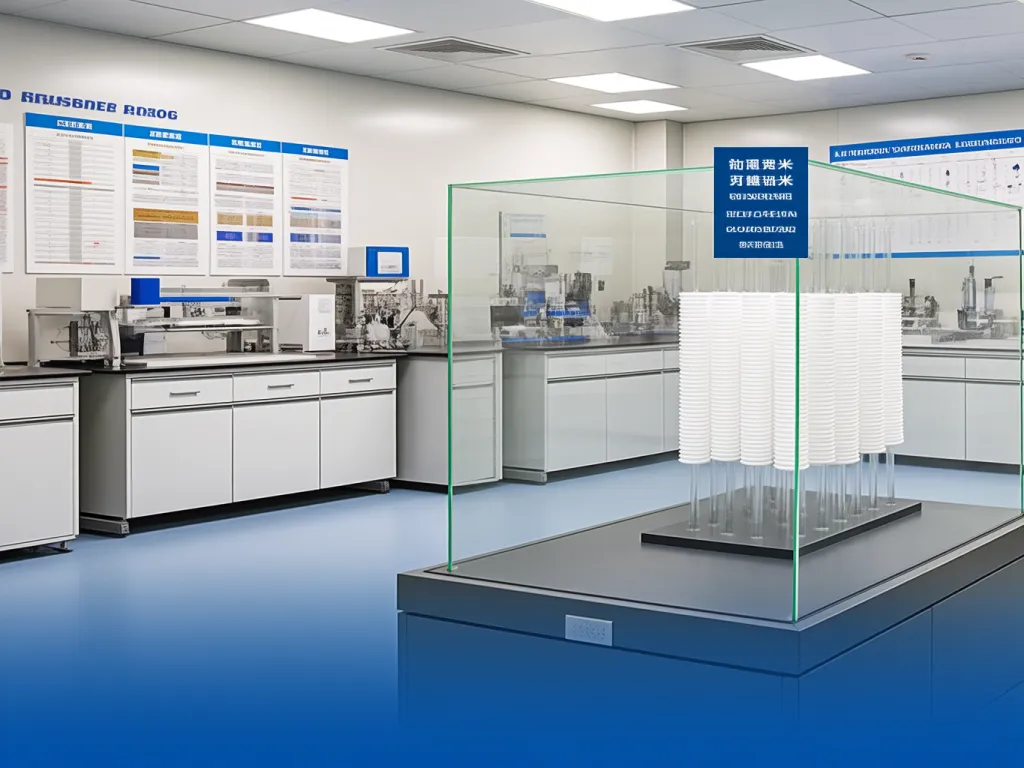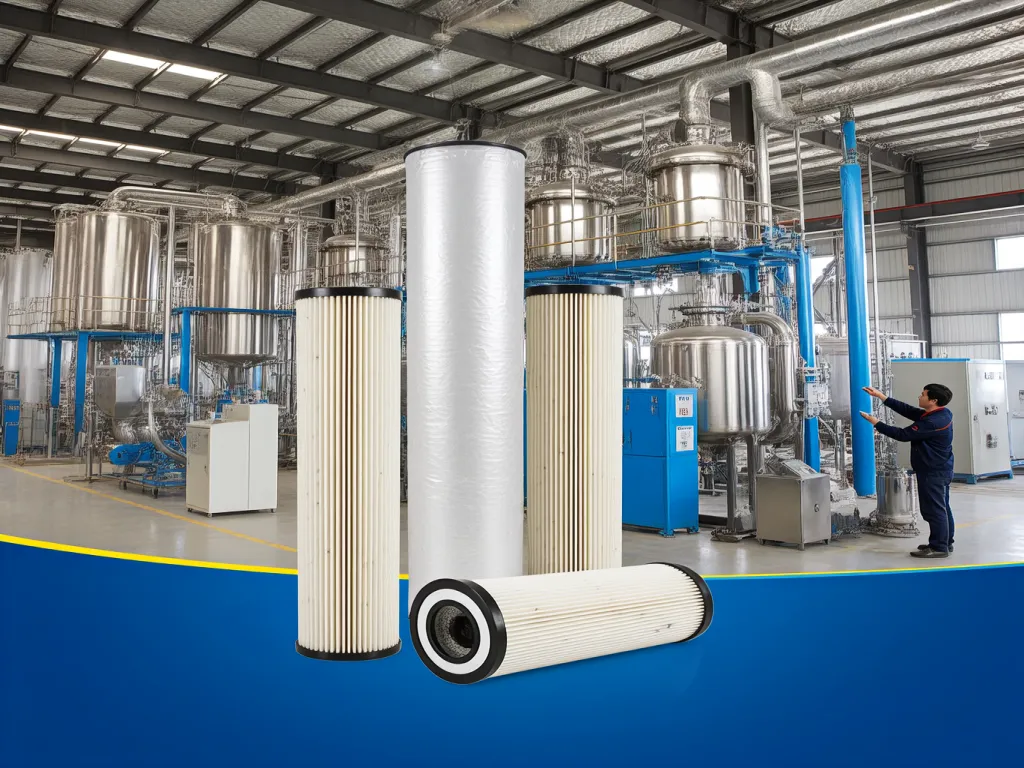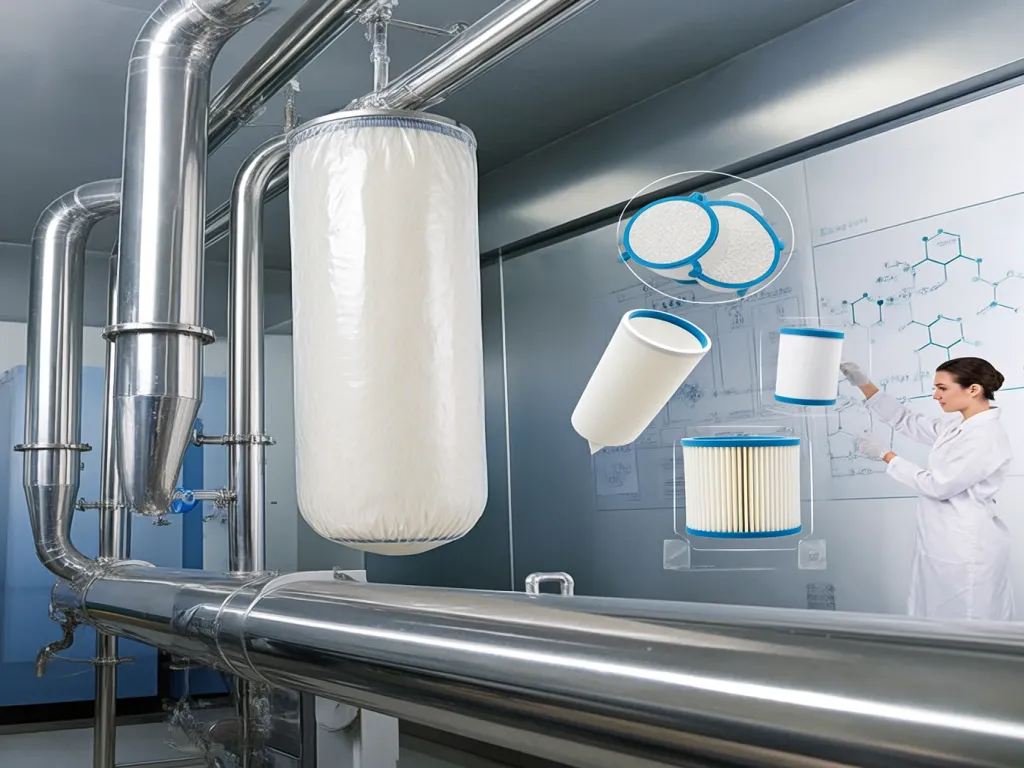Filter Bag 5 Micron: Unveiling Material Secrets

When it comes to industrial filtration, precision matters. The filter bag 5 micron stands as a cornerstone for achieving clean, efficient processes across diverse sectors. But with a range of materials available, how do you pick the perfect fit for your specific scenario? Whether you’re battling extreme temperatures, corrosive chemicals, or stringent hygiene standards, the right material choice can make or break your filtration system’s performance. Let’s dive into the world of 5-micron filter bags and uncover which material aligns best with your industrial demands.

Polyester 5 Micron Filter Bags: Stability in High-Temperature and Highly Corrosive Chemical Environments, Balancing Filtration Efficiency and Cost-Effectiveness
When it comes to industrial filtration, the choice of filter bag material can make or break your system’s performance, especially in demanding environments. Polyester 5 micron filter bags have emerged as a popular choice for scenarios involving high temperatures and aggressive chemical exposure. But why? Let’s dive into the science behind their stability, efficiency, and cost benefits.
High-Temperature Resilience: Polyester’s Secret Sauce
Polyester fibers are engineered to withstand extreme heat without compromising structural integrity. Unlike natural fibers that may shrink, melt, or degrade under high temperatures, polyester maintains its form and filtration capabilities. This makes it ideal for industries like steel manufacturing, incineration, and chemical processing, where temperatures can soar beyond 200°C (392°F). The thermal stability of polyester ensures consistent filtration performance, reducing downtime and maintenance costs associated with filter bag replacement. For a deeper understanding of how polyester performs in high-temperature settings, consider exploring our range of polyester pocket filter bags, designed specifically for such conditions.
But how does this translate to real-world savings? Imagine a scenario where a less heat-resistant material would require frequent replacements due to thermal degradation. With polyester, you’re looking at a longer lifespan, fewer interruptions, and ultimately, lower operational costs. It’s a win-win for both efficiency and budget.
Chemical Corrosion Resistance: A Shield Against Aggression
Industrial processes often involve harsh chemicals that can eat away at filter materials. Polyester, however, boasts excellent resistance to a wide range of acids, alkalis, and organic solvents. This chemical inertness means that polyester 5 micron filter bags can handle corrosive environments without deteriorating quickly. For instance, in electroplating facilities or chemical production plants, where acidic fumes and liquids are commonplace, polyester filters provide reliable protection against contamination while resisting chemical attack. For environments with particularly aggressive chemicals, you might also consider our PTFE-coated polyester dust filter bags, which offer enhanced chemical resistance.
The implications here are significant. By choosing a chemically resistant material like polyester, you’re extending the service life of your filter bags, reducing waste, and minimizing the environmental impact of frequent replacements. Plus, the consistent filtration efficiency ensures that your products meet stringent quality standards, avoiding costly rejections or recalls.
Filtration Efficiency: Precision at the Micron Level
Now, let’s talk about the core function of any filter bag: filtration efficiency. A 5 micron rating means that these polyester bags can capture particles as small as 5 microns in diameter. This level of precision is crucial in industries where even microscopic contaminants can compromise product quality or equipment performance. Whether it’s pharmaceuticals, food and beverage, or electronics manufacturing, polyester 5 micron filter bags deliver the cleanliness required for high-value processes.
But efficiency isn’t just about particle size; it’s also about flow rate and pressure drop. Polyester’s uniform pore structure ensures optimal airflow while maintaining high filtration rates. This balance between capture efficiency and flow resistance means that your systems can operate at peak performance without unnecessary energy consumption or pressure buildups.
Cost-Effectiveness: The Long-Term View
At first glance, polyester filter bags might seem more expensive than some alternatives. However, when you factor in their extended lifespan, reduced maintenance needs, and consistent performance, the cost-benefit analysis starts to tilt in their favor. Think about the total cost of ownership, not just the upfront price tag. By investing in polyester, you’re likely to see significant savings over time through fewer replacements, less downtime, and improved product quality.
Moreover, the versatility of polyester allows it to adapt to various industrial settings, reducing the need for multiple filter types. This consolidation simplifies inventory management and further drives down costs. It’s a strategic choice that aligns with long-term profitability and operational efficiency.
Making the Right Choice for Your Application
So, how do you know if polyester 5 micron filter bags are the right fit for your industrial needs? Consider the following questions:
- Are you operating in high-temperature environments?
- Do your processes involve corrosive chemicals?
- Is particle size control critical to your product quality?
- Are you looking to optimize long-term costs and reduce maintenance?
If you answered ‘yes’ to any of these, polyester might just be your ideal solution. But don’t stop here; explore further by comparing it with other materials like polypropylene or PTFE to ensure you’re making the most informed decision.
Polyester vs. Alternatives: A Comparative Look
While polyester shines in high-temperature and chemically aggressive settings, it’s essential to understand how it stacks up against other materials. Polypropylene, for example, offers excellent chemical resistance but may falter under prolonged heat exposure. PTFE, on the other hand, excels in extreme conditions but comes at a premium cost. For specific applications requiring high-temperature resistance and chemical stability, consider our fiberglass filter bags as another robust option. By weighing these factors, you can tailor your filter bag selection to your specific operational demands.

Polypropylene 5 Micron Filter Bags: Advantages in Low-Contamination, High-Hygiene Scenarios and Lifespan Considerations
When it comes to industrial filtration, choosing the right material for your filter bags is crucial. Among the various options available, polypropylene 5 micron filter bags have carved out a unique niche, especially in scenarios where low contamination and high hygiene standards are non-negotiable. Let’s dive into why these filter bags are the go-to choice for water treatment and food processing industries, and how their lifespan plays into the overall cost-effectiveness.
Polypropylene, a thermoplastic polymer, boasts several inherent properties that make it ideal for applications requiring cleanliness and resistance to chemical degradation. Unlike some other materials, polypropylene doesn’t absorb moisture, which means it won’t swell or degrade when exposed to water-based solutions. This characteristic is a game-changer in water treatment plants, where filter bags need to withstand constant exposure to water without compromising their structural integrity or filtration efficiency.
In the realm of food processing, hygiene is paramount. Polypropylene 5 micron filter bags shine here because they’re inherently resistant to microbial growth. The smooth surface of polypropylene doesn’t provide a conducive environment for bacteria or other microorganisms to thrive, reducing the risk of contamination in food products. This is a critical factor, as any compromise in hygiene can lead to severe health hazards and regulatory non-compliance.
Now, let’s talk about the 5 micron rating. This specification refers to the size of the particles that the filter bag can effectively capture. In water treatment, for instance, a 5 micron filter bag can trap fine sediments, algae, and even some bacteria, ensuring the water is clean and safe for consumption or further processing. Similarly, in food processing, it can filter out impurities and particulates that could affect the taste, appearance, or shelf life of the final product.
But what about the lifespan of these filter bags? After all, durability and cost-effectiveness go hand in hand. Polypropylene 5 micron filter bags are known for their longevity, especially when compared to some other materials. Their resistance to chemicals and moisture means they don’t degrade as quickly, translating to fewer replacements and lower operational costs over time. However, it’s essential to note that the lifespan can vary based on the specific application and operating conditions. For example, in highly corrosive environments, even polypropylene might have a shorter lifespan compared to more specialized materials. But for most low-contamination, high-hygiene scenarios, polypropylene 5 micron filter bags offer an excellent balance between performance and cost.
So, how do you ensure you’re getting the most out of your polypropylene 5 micron filter bags? Regular maintenance is key. This includes periodic cleaning (if the application allows for it) and timely replacement when signs of wear or reduced efficiency become apparent. Additionally, working with a reputable supplier who can provide high-quality filter bags tailored to your specific needs can make all the difference.
In conclusion, polypropylene 5 micron filter bags are a stellar choice for industries where cleanliness and chemical resistance are top priorities. Their ability to maintain structural integrity and filtration efficiency in water treatment and food processing applications, coupled with their relatively long lifespan, makes them a cost-effective solution. By understanding your specific needs and working with a trusted supplier, you can ensure your filtration system operates at peak performance, safeguarding both your products and your bottom line.

Other Materials in 5 Micron Filter Bags: A Comparative Analysis
When it comes to choosing the right 5 micron filter bag for your industrial application, the material selection is as crucial as the micron rating itself. Beyond polyester and polypropylene, materials like nylon and PTFE (Polytetrafluoroethylene) offer unique advantages tailored to specific industrial needs. Let’s dive into the characteristics of these materials and explore their suitability across various industrial landscapes.
Nylon, known for its exceptional strength and durability, stands out as a top choice in environments where mechanical stress and abrasion are prevalent. Its high tensile strength makes it resistant to tearing, even under heavy loads, ensuring longevity and reliability. Nylon 5 micron filter bags excel in applications involving coarse particulates or where frequent cleaning cycles are necessary, as they can withstand the rigors of backwashing without compromising filter integrity. Industries such as mining, cement production, and metalworking benefit greatly from nylon’s robustness, where the filter bags must endure harsh conditions without frequent replacements.
On the other hand, PTFE, often referred to by its brand name Teflon, offers unparalleled chemical resistance and thermal stability. This material is virtually impervious to most chemicals, including acids, bases, and solvents, making it ideal for use in highly corrosive environments. PTFE 5 micron filter bags are the go-to option in chemical processing, pharmaceuticals, and semiconductor manufacturing, where maintaining product purity and preventing contamination are paramount. Additionally, PTFE’s low friction coefficient reduces clogging, enhancing flow rates and extending filter life. Its ability to withstand extreme temperatures, both hot and cold, further broadens its application scope, from cryogenic processes to high-temperature incineration.
But how do you decide between nylon and PTFE, or even consider other materials not yet discussed? The key lies in understanding your specific industrial requirements. Are you dealing with abrasive particles that demand a tough, tear-resistant filter? Nylon might be your best bet. Or, is your process plagued by aggressive chemicals that could degrade less resistant materials? PTFE would then be the logical choice.
It’s also worth mentioning that while nylon and PTFE are prominent, other materials like polyester felt, glass fiber, and even stainless steel mesh can also be fabricated into 5 micron filter bags, each with its own set of advantages. Polyester felt, for instance, offers a good balance between cost and performance, suitable for general-purpose filtration. Glass fiber, with its high temperature resistance and excellent particle retention, finds use in hot gas filtration. Stainless steel mesh, though less common in 5 micron ratings due to cost and complexity, provides unmatched durability and is reusable, making it a sustainable option in certain niche applications.
In making your selection, consider not just the immediate filtration needs but also the long-term operational costs. A slightly more expensive PTFE filter bag might prove more economical over time if it means fewer replacements and less downtime due to filter failures. Conversely, a nylon filter bag could offer the best value in scenarios where its durability translates directly into extended service life and reduced maintenance expenses.
Ultimately, the ‘right’ material for your 5 micron filter bag hinges on a thorough evaluation of your industrial processes, the nature of contaminants, and your budgetary constraints. By weighing these factors carefully, you can select a filter bag that not only meets your current filtration demands but also aligns with your broader operational goals.
Nylon: Strength and Durability Personified
Nylon’s reputation for strength and durability is well-earned. Its high tensile strength ensures that even under the most strenuous conditions, the filter bag remains intact, preventing particulate escape and maintaining filtration efficiency. This makes nylon an excellent choice for industries where the filter bags are subjected to constant mechanical stress, such as in vibrating screens or where backwashing is a regular part of the maintenance routine. The ability to withstand repeated cleaning cycles without degradation means fewer replacements and lower operational costs over time.
PTFE: Chemical Resistance and Thermal Stability
PTFE’s chemical inertness is its crown jewel. In environments where exposure to corrosive substances is inevitable, PTFE filter bags provide a barrier that few other materials can match. This chemical resistance, combined with its thermal stability, allows PTFE to function effectively across a wide temperature range, from sub-zero to several hundred degrees Celsius. Such versatility makes PTFE indispensable in industries where maintaining product integrity and preventing contamination are non-negotiable, such as in the production of pharmaceuticals or semiconductors.
Beyond Nylon and PTFE: Exploring Other Materials
While nylon and PTFE dominate the conversation around specialized 5 micron filter bags, it’s essential not to overlook other viable options. Polyester felt, for instance, offers a cost-effective solution for general filtration needs, balancing performance with affordability. Glass fiber, with its exceptional heat resistance and fine particle retention, is suited for high-temperature applications like incinerator exhaust filtration. Stainless steel mesh, though less common in 5 micron ratings, provides a reusable, durable alternative for specific industrial processes where longevity and resistance to corrosion are critical.
Selecting the ideal filter bag 5 micron material isn’t just about specs—it’s about matching your unique industrial challenges with solutions that deliver durability, efficiency, and cost-effectiveness. From polyester’s resilience in harsh conditions to polypropylene’s hygiene-friendly appeal, each material offers distinct advantages. By weighing these factors against your operational needs, you’re poised to elevate your filtration system’s performance. Still unsure? Our experts are here to guide you through every step. Ready to transform your industrial filtration? Let’s get started!

